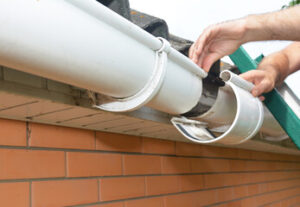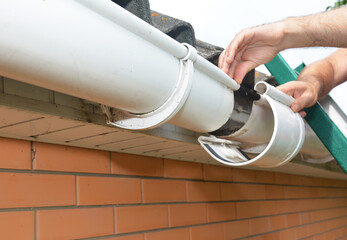Proper Gutter Installation Murfreesboro TN prevents costly water damage and safeguards your home. A professional evaluates your roof and local weather to recommend the best solution. They ensure proper sloping and downspout location for efficient water flow, minimizing clogs and leaks.
They also ensure uniform gutter spacing and straight end caps. This meticulous work results in a seamless system that performs flawlessly for years.
Gutters might be one of the most DIY-friendly projects homeowners can take on, but they do require a certain level of expertise and precision. The right gutters protect your home from water damage and can increase its value.
Whether you’re replacing old gutters or installing them in a new construction, here are some dos and don’ts for a successful installation.
Plan the project before you start. Take into account the size of your roof, the weather in your area and your aesthetic preferences. Then, get all the materials you’ll need together before starting. This will make the process go much smoother. Don’t forget safety gear, like goggles and gloves, and a ladder that is stable enough for the work you have in mind.
Before installing new gutters, check for damage to the fascia boards and rotted wood. If you see any signs of these issues, have them repaired prior to the installation process. This can prevent problems with the new gutters in the future and ensure that your roof is protected.
It’s important to have the gutters pitched correctly. If the pitch is too low, the gutters may overflow during a rainstorm. A professional gutter installer will know how to properly angle the gutters for a functional and long-lasting setup.
The gutters should be slanted in order to direct water away from the house’s foundation, siding and landscaping. The gutters should also be positioned so that downspouts can divert water eight to 10 feet away from the foundation. This will keep the water from causing damage to your home’s foundation and landscaping in the long run.
A gutter system should have a downspout every 30 to 40 feet of gutter length. Downspouts are essential for draining the collected rainwater and preventing premature deterioration of your roof deck and shingles. It’s a good idea to mark the location of downspouts on the gutter with a washable chalk line before beginning the installation process. This will help you get the alignment right and avoid directing water into walkways or your home’s foundation. A downspout should always drain to a lower gutter, never directly onto your roof.
Materials
Gutter systems come in a variety of materials with unique benefits and drawbacks. You’ll want to carefully consider your budget, climate, and aesthetics to select the best material for your needs. Aluminum and vinyl gutters are cost-effective and rust-resistant, while copper and zinc are more expensive but can stand up to harsh weather conditions and add an elegant look to your home.
During installation, it’s important to use the proper tools and materials to avoid damage and ensure watertight connections. This includes the gutter system itself, downspouts, elbows, end caps, and brackets. Make sure to have all the necessary supplies on hand before beginning the project to minimize delays and save time.
To start, measure the length of your roof edge and note any corners that need special fittings. Next, calculate the total number of gutter sections you’ll need based on your measurements and plan where downspouts will go. Make sure that each downspout is positioned at least 40 feet from the house to prevent flooding.
You’ll also need to choose a color and style for your gutter system. While some homeowners prefer a more minimalist approach, others like to customize their gutters with different colors and shapes to match their style. Once you’ve selected your gutter system, it’s time to install it. Start by securing the brackets to the fascia with lag screws. Then, lift the gutter until its back edge slips into the hooks on top of the brackets.
Attach the downspout outlet to the end of the gutter with a pair of elbows. Position the elbows so that their outside edges rest against the gutter and inside edges face away from it. Mark where the downspout hole will go on the low end of the gutter and trace a circular outline with a pencil. Then, cut a 4-inch-diameter hole through the gutter with a utility knife or hammer and cold chisel. Use high-quality siliconized caulk to seal the hole.
Lastly, attach the downspout to the gutter with a bracket called a pipe cleat. These brackets fasten to the side of post-frame buildings and prevent downspouts from detaching or pulling out under heavy snow loads or rain.
Layout
The layout of the gutter system plays a critical role in efficient water drainage. A thorough assessment of the architectural features of your property can help you determine the best gutter configuration for your home, as well as the optimal slope of your gutter run. This is a crucial step because a gutter that is not properly sloped can lead to clogging, overflows, and even leakage.
Gutter installation is a complex undertaking, and one that requires professional expertise to ensure lasting performance. Considering the countless factors that can influence the timeline of a gutter installation, clear communication and flexibility are essential for navigating these challenges effectively.
Start by assessing your roofline and the layout of your gutters. Determine how many downspouts you need to ensure adequate water flow. You can measure the length of your gutters using a tape measure or ladder. Then mark the location of the downspouts with a washable chalk line. You may need to add elbows to guide the water flow around corners or obstructions. For a smooth, consistent finish, use prefabricated corner pieces to join the sections of your gutters.
Before beginning the actual gutter installation, you will need to prepare your materials and tools. Be sure to have all the necessary tools, including a ladder, safety gear, and a rain gutter installer kit with gutter hangers, sealant, and downspout connectors. You should also prepare the area where you will install your gutters by removing any obstructions and leveling the ground as needed.
The contractor will install the gutters on your roofline by locating the rafter tails and mounting the fascia brackets, which should be spaced approximately every two feet. The contractor will then cut the gutters to size, leaving 1.25 inches below the edge flashing and a 1/2 inch downward slope. They will then secure the brackets to the fascia boards and attach the downspout tubes, making sure to place them at least 8 inches away from the foundation of your house.
If you choose to install seamless gutters, the contractor will secure them to the fascia boards with long spikes and ferrules. If you choose the hidden hanger method, however, the spikes and ferrules will be concealed beneath the gutter for a more sleek look.
Downspouts
Downspouts are a critical part of any gutter system, and it’s crucial to install them properly. They are designed to take the water from the gutter and deposit it away from your home or building foundation, preventing soil erosion, basement flooding, and other serious issues. Downspouts are typically shaped like pipes and installed on the sides of buildings.
When you’re installing a downspout, make sure it’s positioned so that the bottom end is 6 inches to 1 foot above the ground. This height helps ensure that the water is deposited far enough away from the foundation, and it also prevents backflow and splashing against the house. You can also use downspout extensions or a splash block to further manage water flow and reduce the risk of soil erosion and basement flooding.
If you’re unsure about how to install downspouts, it’s best to leave the task to a professional gutter installation expert. They will have the proper equipment and tools for a safe and effective job. If you’re going to do the job yourself, remember to always wear protective equipment and be careful when working with ladders. Always position the ladder securely on stable ground, and be sure to check that it’s locked before climbing.
Depending on the type of gutter system you choose, there are different types and materials of downspouts. Vinyl is a popular option because it’s affordable and can last for decades. Zinc is another durable material that’s corrosion-resistant and can withstand freezing temperatures. Steel downspouts are another option, and they’re often used in areas that experience heavy rainfall.
Downspouts are also a great way to add curb appeal to your home. They come in a variety of colors and can be easily customized to suit your home’s design. You can also add decorative touches, such as copper accents and a downspout screen to keep debris out of the gutter.
If you’re experiencing problems with your downspouts, it may be time to replace them. Visible rust, leaks, and frequent clogs are all signs that it’s time to consider replacement. If left unchecked, these problems can cause extensive and expensive damage to your home or building foundation, landscaping, basement, or other parts of your property.
